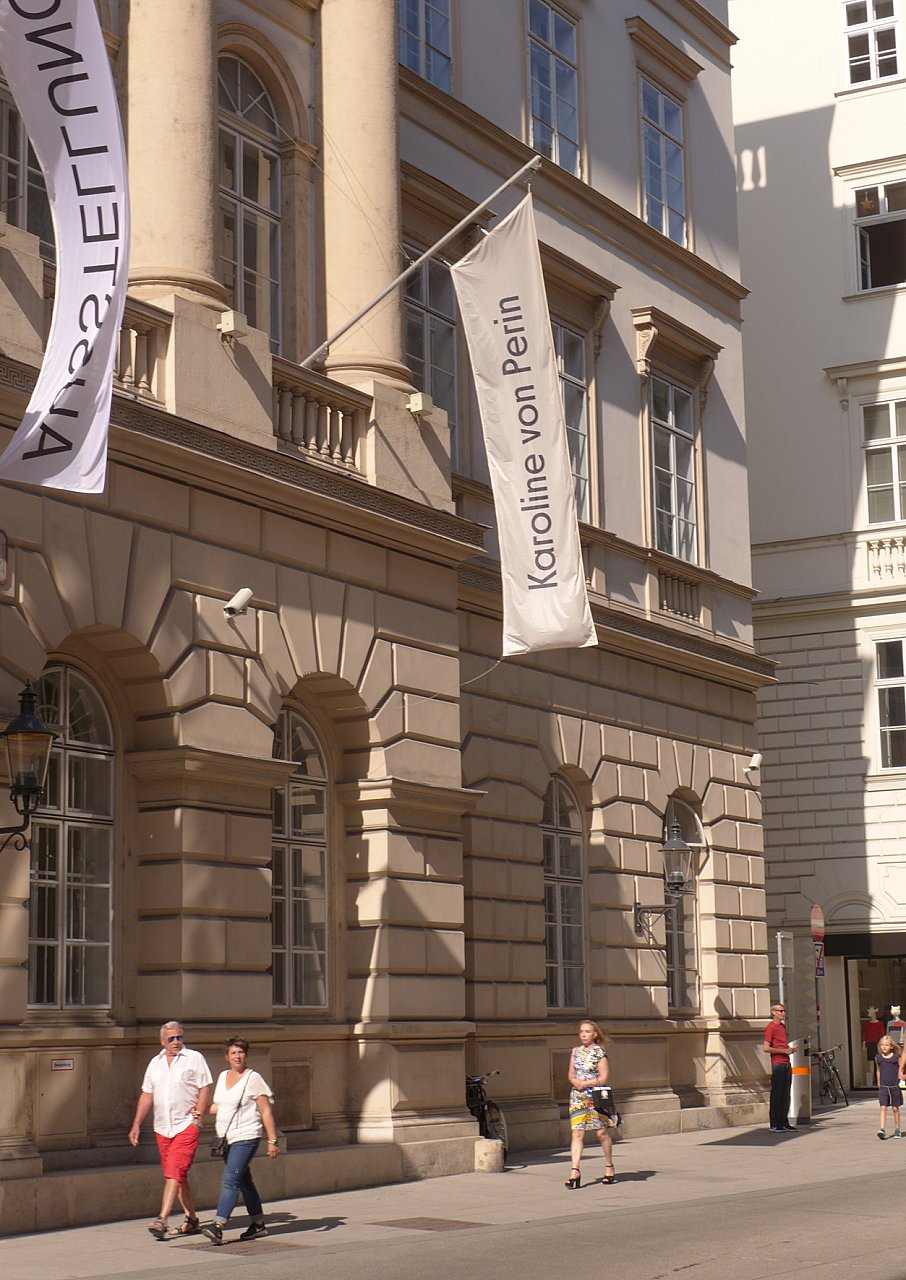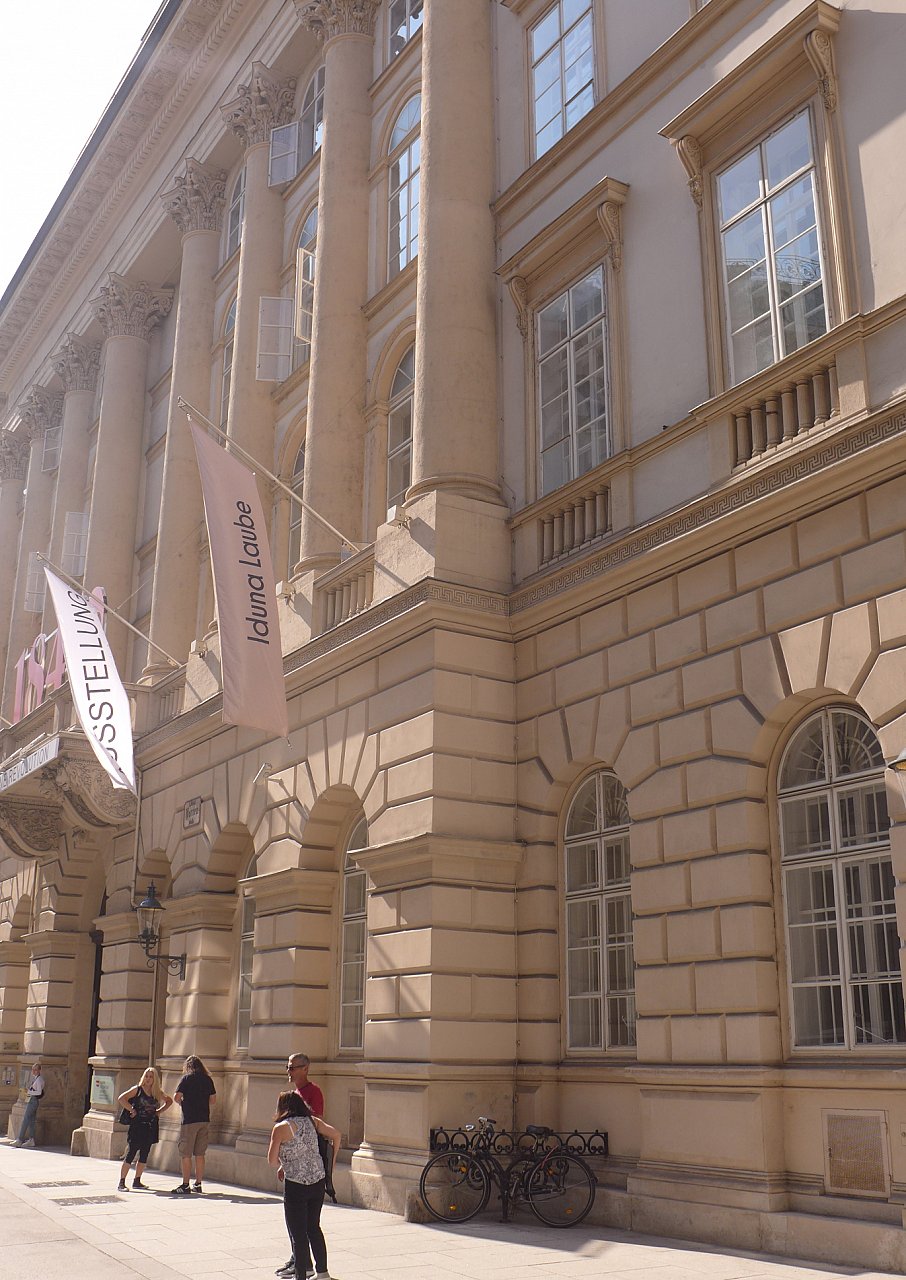Tatiana Lecomte „Frauen und Mädchen!“
Intervention beim Palais Niederösterreich
Herrengasse 13, 1010 Wien
17. bis 17. November 2018
Ein Projekt der Abteilung Kunst und Kultur des Landes Niederösterreich / Kunst im öffentlichen Raum mit Unterstützung des Kunstraum Niederoesterreich und des Palais Niederösterreich.


Fahne Nr. 1:
Karoline von Perin, Iduna Laube
Herrengasse 13, 1010 Wien
17. bis 17. November 2018
Ein Projekt der Abteilung Kunst und Kultur des Landes Niederösterreich / Kunst im öffentlichen Raum mit Unterstützung des Kunstraum Niederoesterreich und des Palais Niederösterreich.


Fahne Nr. 1:
Karoline von Perin, Iduna Laube
“It is equitable that all female subjects be accorded exactly the same rights as the male population.”[1]
“Mrs. Pauli […] called on women to form organizations to create an effective and united front against reaction and terror, the greatest enemies of women’s freedom.”[2]
Tatiana Lecomte selected these two quotes, along with 50 other passages, taken from journals, lectures, and petitions to serve as reminders of the 70 years, from 1848 to 1918, of the fight for women’s rights in Austria—70 years during which women were not allowed to form organizations or campaign for their right to political participation, but also 70 years during which they nonetheless found ways to raise public awareness of their concerns. Lecomte printed the quotes, whose authors are generally unknown, on flyers, which were handed out in front of the Palais Niederösterreich over a period of two months. Additionally, a new flag was raised every week to commemorate one of the representatives of the Austrian women’s movement.
With her project, the artist intervened in the official politics of remembrance in the public realm. She turned the spotlight on women and their fight for equality without creating a monument for them in the traditional sense. Instead, the ephemeral project acted as a counterpoint to the longevity of monuments. Lecomte’s flyers referred back to the media strategies used already in 1848 to raise awareness of revolutionary causes. Instead of concentrating her commemoration on a single location, Lecomte let the flyers with historical quotes spread all over the city. Furthermore, she did not commemorate one great woman; she called attention to the efforts of countless women, many of whose names we do not even know.
The quotes from the beginning suggest that the history of emancipation had a narrative arc, with a beginning, a climax, and a happy end. Although the flyers with the quotes were distributed in a chronological order, they were not meant to tell a linear story. Instead, they let many different voices be heard and highlighted various interests. For example, there were labor movement representatives, landowners, teachers, artists, and leaders of Catholic and Jewish social welfare organizations. Some of the quotes were also from men who supported the women’s cause, or who wanted to maintain the status quo.
Despite their temporary nature, the flyers lent the selected passages taken from past debates a new form and a new materiality. The placement of several quotes next to each other without comment also corresponded to the principle of montage, which for the last few years the artist has been using as a formal strategy for found photographs as a way of analyzing racist image politics and the question of whether historical events can be represented through photography. Walter Benjamin regarded montage as a model for a different form of writing, like the one he used in his book Arcades Project, which was intended to consist only of quotes. As he sums up: “Method of this project: literary montage. I needn’t say anything, merely show.”[3]
“Mrs. Pauli […] called on women to form organizations to create an effective and united front against reaction and terror, the greatest enemies of women’s freedom.”[2]
Tatiana Lecomte selected these two quotes, along with 50 other passages, taken from journals, lectures, and petitions to serve as reminders of the 70 years, from 1848 to 1918, of the fight for women’s rights in Austria—70 years during which women were not allowed to form organizations or campaign for their right to political participation, but also 70 years during which they nonetheless found ways to raise public awareness of their concerns. Lecomte printed the quotes, whose authors are generally unknown, on flyers, which were handed out in front of the Palais Niederösterreich over a period of two months. Additionally, a new flag was raised every week to commemorate one of the representatives of the Austrian women’s movement.
With her project, the artist intervened in the official politics of remembrance in the public realm. She turned the spotlight on women and their fight for equality without creating a monument for them in the traditional sense. Instead, the ephemeral project acted as a counterpoint to the longevity of monuments. Lecomte’s flyers referred back to the media strategies used already in 1848 to raise awareness of revolutionary causes. Instead of concentrating her commemoration on a single location, Lecomte let the flyers with historical quotes spread all over the city. Furthermore, she did not commemorate one great woman; she called attention to the efforts of countless women, many of whose names we do not even know.
The quotes from the beginning suggest that the history of emancipation had a narrative arc, with a beginning, a climax, and a happy end. Although the flyers with the quotes were distributed in a chronological order, they were not meant to tell a linear story. Instead, they let many different voices be heard and highlighted various interests. For example, there were labor movement representatives, landowners, teachers, artists, and leaders of Catholic and Jewish social welfare organizations. Some of the quotes were also from men who supported the women’s cause, or who wanted to maintain the status quo.
Despite their temporary nature, the flyers lent the selected passages taken from past debates a new form and a new materiality. The placement of several quotes next to each other without comment also corresponded to the principle of montage, which for the last few years the artist has been using as a formal strategy for found photographs as a way of analyzing racist image politics and the question of whether historical events can be represented through photography. Walter Benjamin regarded montage as a model for a different form of writing, like the one he used in his book Arcades Project, which was intended to consist only of quotes. As he sums up: “Method of this project: literary montage. I needn’t say anything, merely show.”[3]
[1] “Gleichstellung der Rechte der Frauen mit jenen der Männer” (The Same Rights for Women and Men), pamphlet, Vienna, 1848.
[2] “Erste politische Versammlung des allgemeinen österreichischen Frauenvereins” (First Political Assembly of the General Austrian Women’s Association), Zeitschrift für Frauen-Stimmrecht, Vienna: December 1918.
[3] Walter Benjamin, The Arcades Project, trans. Howard Eiland and Kevin McLaughlin (Cambridge, MA and London: The Belknap Press of Harvard University, 1999), 460. Emphasis in original.

